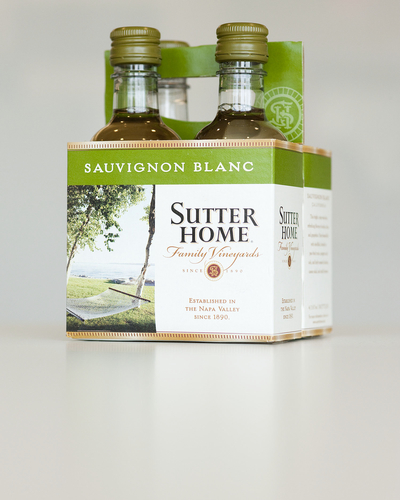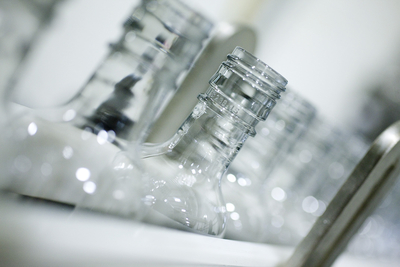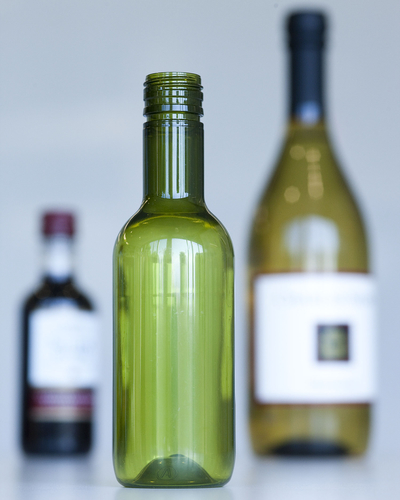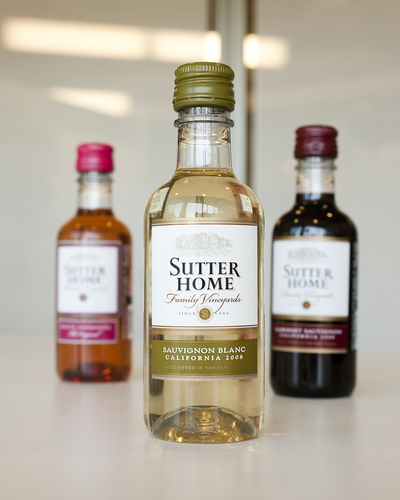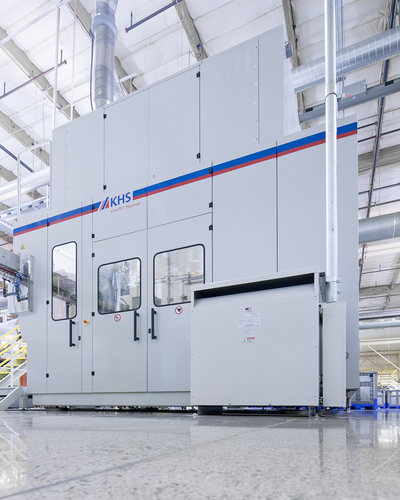
Lightweights for the American Wine Industry
Amcor Rigid Plastics grows with PET wine bottles and KHS Plasmax barrier-coating technology
With over 300 plus locations in a total of 42 countries, around 33,000 employees worldwide, and a turnover of 12.6 billion US dollars during the fiscal year ending June 30, 2011, Amcor is now the largest listed global packaging company. Amcor's sphere of manufacturing activity ranges from glass, carton, and metal packaging through flexible plastic packing to rigid plastic packaging. One factor that is of great interest to the beverage industry in particular is the rigid plastic packaging sector and thus the sector in which Amcor Rigid Plastics is active. Amcor Rigid Plastics, headquartered in Ann Arbor, Michigan, runs 43 plants in 13 different countries and 32 additional facilities co-located with customers, the main focus being on North and South America. The enterprise produces about 28 billion units a year. Beyond the food and pharmaceuticals industries, it supplies the beverage industry with plastic bottles for non-alcoholic beverages and also beer, wine, and spirits. Recently, focus has shifted towards providing wine in PET bottles. In the following interview, Fred Piercy, business director for spirts, wine and beer at Amcor Rigid Plastics, speaks about how this development came about, why wine in PET is being received positively, especially in the USA, how winemakers are profiting from the PET bottle trend, what the future could look like for wine in PET, and – most importantly – which specific requirements must be made of PET bottles for wine. Mr Piercy, what do you think are the reasons for wine in PET bottles becoming more prominent with consumers in the USA? Piercy: First of all, there are the general advantages that come with the PET bottle. Consumers like the light, non-breakable bottles and often opt for this convenient type of container – once they're convinced that the wine in PET bottle is of a good quality. Besides the lightweight and non-breakability of PET bottles, wine companies also consider the advantages in transportation and truck utilization of the lightweight and smaller footprint containers. This provides for a sustainable solution. Incidentally, in the interest of sustainability we only supply our clients with PET wine bottles that are 100% recyclable. Concentration on convenience Who do you consider to be the main target groups for wine in PET? Piercy: Young adults are showing great interest in the PET bottle for wine, for instance. They are particularly receptive to innovative container concepts. At the same time they're always on the move and appreciate the convenience they have in a lightweight, non-breakable PET bottle. Furthermore, we count particularly convenience-oriented consumers of all legal drinking ages as part of our main target group. These include consumers who don't want to carry heavy wine bottles back home with them after a big shopping trip, for example, or consumers who buy wine that they drink in venues outside the home. In demand with retailers and also of interest to airlines Is retail the main sales channel for wine in PET bottles or is the hospitality trade also showing some interest? Piercy: Wine in PET is chiefly in demand with retailers. However, we are seeing an increase in demand from airlines. For example, the Cecchetti Wine Company from California supplies 187-ml PET bottles of their Red Tree brand wines to Air Canada, British Airways, and Continental Airlines. According to Roy Cecchetti, president of the Cecchetti Wine Company, Airlines see the advantage of the lightweight PET wine bottle in the lower use of fuel – which in turn gives them sustainability and cuts costs. For air traffic the non-breakability of PET bottles is also a major criterion, and it's important that Amcor provides PET wine bottles that preserve the quality of the wine as perfectly as traditional glass bottles do." This point of view is shared by Aldo Geloso, president of the Société De Vin Internationale Ltée. The Société De Vin Internationale Ltée is based in Canada and has recently started filling many of its fine wines into 1-liter PET wine bottles destined for airlines. It already works in close collaboration with Air Transat, one of the biggest charter airlines in Canada. Air Transat decided to start using the container after resonance from passengers during the text phase proved extremely positive. At 54 grams the 1-liter PET wine bottle for Air Transat weighs just an eighth of the 1-liter receptacle made of glass. Geloso reckons on more airlines showing an interest in his wine brands in the 1-liter PET bottle in the future. He is also thinking about bottling products such as cider in smaller 330-ml and 500-ml sizes of PET bottle and selling these through the retail trade. The 187-ml PET bottle to the fore Which sizes of PET bottle for wine are particularly popular in the USA? The 187-ml PET bottle is extremely popular, with most US consumers buying it in packs of four. If the consumer fancies a glass of wine, he or she opens one of the little bottles and consumes it at one sitting. The 187-ml PET bottle thus also incorporates the idea of freshness. As we see it, there will be an increased move towards the 187-ml PET bottle in the coming years. In the long term we expect that glass wine bottles of this size may no longer be available on the market, being instead replaced by the PET variety. How high is the percentage of PET wine bottles currently consumed in the USA compared to glass wine bottles, and what percentage of these can be allocated to the 187-ml PET bottle? Piercy: The current share of PET wine bottles in the USA is around 4%. Considering that wine in PET only really became relevant here about five years ago, this is a very good result. Ninety percent of all wines filled in PET reaches the consumer in the 187-ml PET container. For the future we can see clear growth potential for this size of bottle. At the same time, we also estimate that larger PET wine bottles, such as the 1-liter or 1.5-liter size, will attract more consumer interest. The target group for this larger type of PET bottle could be consumers buying wine for parties with friends, for instance. By the way, in the past few years Amcor has notched up an average yearly growth rate of approximately 10% for PET wine bottles. This again demonstrates that wine in PET is definitely a growth market. For 2011 we are projecting Amcor Rigid Plastics sales of 150 million units for the 187-ml PET wine bottle alone. Rewarding pioneering work at Sutter Home Which wine companies are opting for wine in PET? Chiefly the large companies? Piercy: Yes, that's right. In the USA we mostly supply larger wineries, among them Sutter Home, the market leader for 187-ml wine bottles. Sutter Home was a pioneer when in 2005 they began filling wine into 187-ml PET bottles. The 187-ml PET bottle was designed to look exactly like the 187-ml glass bottle. In addition, the PET bottles could and still can be filled on an existing glass line. Sutter Home – and this is a clear signal to the US market as a whole – has since switched its entire 187-ml bottle range over to lightweight PET containers. According to Wendy Nyberg, marketing director of Sutter Home, consumers are now confident that wine in PET bottles is of the same high quality and keeps as long as wine filled in glass bottles. They were also delighted that the 187-ml PET bottle weighs just a sixth of the glass bottle and is smaller – although it contains an identical amount of wine – and has the added advantage of being unbreakable. Besides Sutter Home, other giants of the US wine industry we supply with PET wine bottles include Fetzer, Hopland, and Sonoma. Top wine quality maintained You've often spoken about consumers being convinced about the top quality of wine filled in PET bottles. What ensures that this top quality is maintained in PET? Piercy: Wine is a sensitive product that doesn't tolerate any oxygen pickup in the container. Amcor has taken great care to select a barrier coating for our PET wine bottles that upholds the quality of the wine to the fullest. In our search for the perfect barrier coating, we came across KHS Plasmax technology. At Amcor we were so convinced by our search and by our experience that we've since made Plasmax technology standard not just for wine but also for beer bottles, which on the US beer market still have an increasingly low market share. Plasmax barrier coating part of the success story of wine in PET What do you think are the major advantages of Plasmax barrier coating? Piercy: During the Plasmax barrier coating process the insides of our PET wine bottles are covered with an ultra-thin, completely transparent layer of glass. This glass layer prevents oxygen penetrating the PET bottles, ensuring that wine filled in a Plasmax-coated bottle has just as long a shelf life as wine bottled in glass. The taste of the wine is also not affected. Another benefit of this process is that PET bottles coated with Plasmax technology are 100% recyclable, making the system sustainable. Do you believe that Plasmax barrier coating of PET wine bottles is part of the success story of wine in PET in the USA? Piercy: Yes, I do. What good is very attractive PET packaging for wine if the container’s performance is not adequate? With this coating we are absolutely sure that our customers in the wine industry have access to wine bottles that maintain the high quality of their products. We are a company that attaches great value to excellent quality and of course we apply this principle to all our dealings with the wine industry. We also appreciate the consultancy KHS gives us, enabling us to always provide our customers with quick possible solutions. What do you appreciate most about this consultancy service? We welcome the fact that KHS is able to answer and advise us on all our questions. They are also always prepared to perform laboratory tests with Plasmax barrier coating on newly designed PET wine bottles. We can always be confident that we are supplying our customers in the wine industry with bottle material that has been tested right down to the last detail. Our customers rely on the fact that we provide them with the best-quality in all respects. In the end, it's this quality and reliability that will boost the popularity of wine in PET. We will continue to move forward step by step together with our customers. We therefore expect that in the next few years, the yearly growth potential for PET wine bottles could be approximately 10%. Mr Piercy, thank you very much for this interview. Quotes: "We are seeing an increase in demand for wine in PET from airlines." "The 187-ml PET wine bottle is particularly popular in the US." "The current share of PET wine bottles in the USA is around 4%." "In our search for the perfect barrier coating for PET wine bottles we came across KHS Plasmax technology. This is inextricably linked to the success story of wine in PET in the USA."
